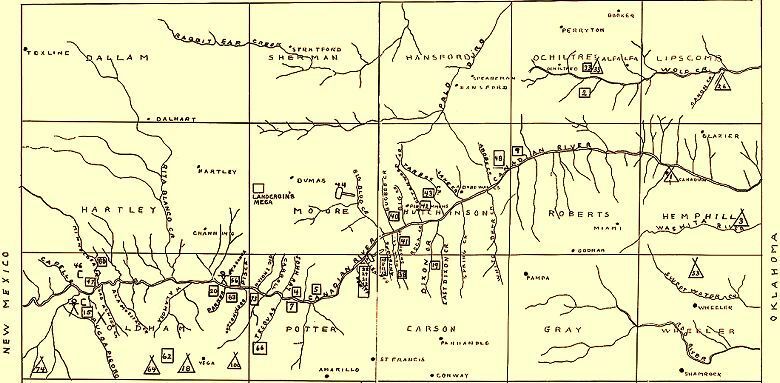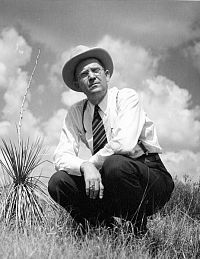
Floyd V. Studer was an explorer, promoter,
civic leader, watchdog, and kingpin, a determined man whose
impact on the study of Plains Village sites in the Texas Panhandle
is hard to exaggerate. This publicity photo was probably taken
around 1940. Panhandle-Plains Historical Society (PPHS) archives. |
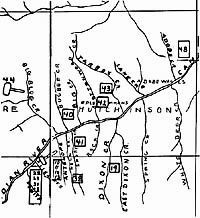
Detail of Hutchinson County area of Studer’s
1931 map of the northern Panhandle that was published by Moorehead.
The map was intentionally incomplete and deliberately misleading
in places—Studer feared that unwanted visitors would
destroy the sites. Click to see larger images and
more of map.
|
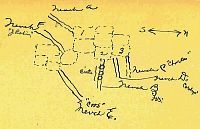
Diagram by Floyd Studer of ongoing work
at Alibates 28 in July, 1932. The apparent excavators are
identified beside each trench, including “FVS”
(Floyd V. Studer), “Carolyn” (Studer), “Charles”
(Renfroe), and “J. Robin” (Allen). During this
period, Studer was assisted by various friends and members
of the Panhandle-Plains Historical Society. Map from the PPHS
archives; identifications by Chris Lintz. |
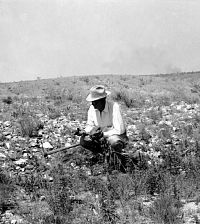
Floyd Studer at the Alibates quarries in
1935. The photo was taken by A. T. Jackson of the University
of Texas during a brief visit to the area. TARL archives.
|
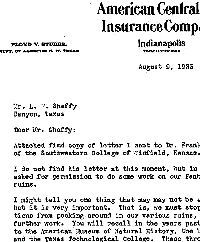
This 1933 letter from Studer to L. F. Sheffy,
the chair of the history department at West Texas State Teachers
College in Canyon, calls attention to the danger of allowing
outside institutions to dig at the Panhandle's Plains Villages.
"We must stop these visiting institutions from
pecking around in our various ruins, and ruining them for
further work." Studer was a prolific correspondent
and this is one of many letters he wrote as a self-styled
advocate and defender of the region's archeological resources.
PPHS archives. Click to see enlarged image of entire
letter. |
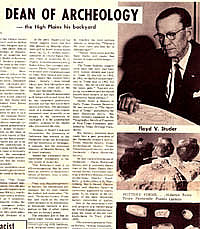
Article on "businessman-historian"
Floyd V. Studer that appeared in the February 5, 1963 edition
of The Amarillo Citzen. PPHS archives. |
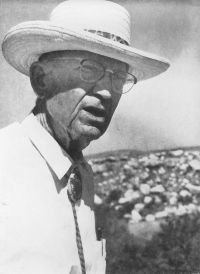
Floyd V. Studer at the 1965 dedication
of the Alibates Flint Quarries National Monument. This photo
appeared in the Amarillo Globe-News. PPHS archives. |
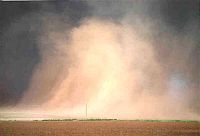
During the prolonged drought of the early
1930, dust storms like this recent example near Turkey, Texas,
turned much of the Southern Plains into a “dust bowl”
and sent many farming families to ruin. Photo by David L.
Arnold, Ball State University. |
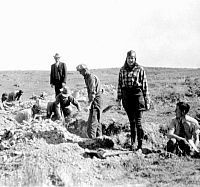
Inspection visit during WPA excavations
at Antelope Creek 22 in 1938 or 1939. C. Stuart Johnston is
on the far right with his young wife Margaret. Floyd Studer
is in the center background facing the camera. |
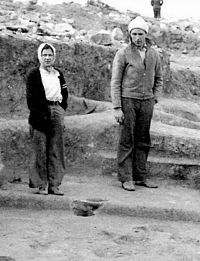
Ele and Jewel Baker at Antelope Creek 22,
probably in the late fall or winter of 1939. PPHS archives. |
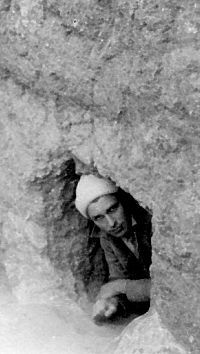
Ele Baker in passageway to Room 2 at Antelope
Creek 22. Studer was much taken by the narrow passageways,
which he thought mainly provided ventilation. He insisted
that the Antelope Creek rooms lacked doorways and that access
must have been through roof entries. PPHS archives |
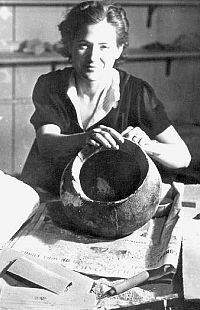
Jewel Baker restoring large Borger Cordmarked
jar at the WPA laboratory at the Panhandle-Plains Museum.
Photo taken in January 1939 by H.C. Pipkin, an Amarillo lawyer
who was one of Studer’s close friends and supporters.
Other photos show Pipkin with expensive photographic equipment,
suggesting that it may have been he who took many of the publicity
photos of the WPA work. PPHS archives. |
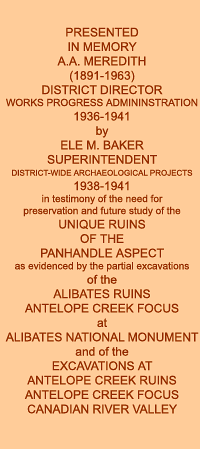
Dedication statement by Ele and Jewel Baker
prepared for the 1968 four-copy edition of their original
WPA reports. |
|
By the late 1920s Floyd V. Studer
controlled access to most of the known Plains Village sites in the
Texas Panhandle. How and why he did this is a part of the fascinating,
but little-known story of a larger-than-life man. Studer was an
explorer, promoter, civic leader, watchdog, and kingpin, a determined
man whose impact on the study of Plains Village sites in the Texas
Panhandle is hard to exaggerate. For over 50 years, from the first
excavation at Buried City through the early 1960s, Floyd Studer
had a strong hand in virtually all archeology done in the Texas
Panhandle.
Studer was bitten badly by the archeology bug as a
15-year-old student during the 1907 expedition to Buried City. Perhaps
it was really more of an exploration bug combined with natural curiosity
and the pride of a native son of the Panhandle. Regardless, from
that day onward Studer sought out any and all archeological sites
in the Texas Panhandle, especially the Plains Villager sites with
masonry ruins. He was also fascinated with the fossil bones of ancient
animals; in the early 20th century, archeology and paleontology
were seen as closely related studies—both involved exploration
and digging. Studer had no formal training in archeology, but as
he put it in 1955:
I have made of it a lifetime relief occupation. … For 45
years, whenever possible, I worked on those ruins—surveying,
mapping, photographing, digging. … While engaged in commercial
activities in Amarillo, this was my relaxation on weekends and
holidays. Every means of transportation made available in those
years was used—shanks’ mare, horseback, buckboard,
motorcycle, Model T, later models—until finally the airplane
solved a lot of the problems.
As Studer explored the Panhandle, he developed an
extensive network of local contacts through personal, family, banking,
and insurance connections. In the 1920s he obtained “scientific
leases” from ranchers within the Canadian Valley that he believed
gave him the right to decide who could investigate the sites. In
part he was motivated by his sense of ownership—it was he
who found and recorded most of these sites and he regarded the Canadian
Breaks as his "turf." Studer also clearly felt a strong
sense of stewardship—like Moorehead, Studer recognized that
many of the sites were threatened by casual artifact seekers, museum
collectors, and development.
Studer played an instrumental role in the Panhandle-Plains
Historical Society and the establishment and development
of the Society’s Panhandle-Plains Historical Museum
in Canyon, the first state museum in Texas. In 1931, two
years before the museum first opened to the public, Studer signed
over his scientific leases to the society and its fledgling museum
in exchange for a non-salaried appointment as the museum’s
Director of Archaeology and Paleontology. This volunteer post gave
him a headquarters and solidified his control of Panhandle archeology
and paleontology for the next two decades. The museum was closely
connected to West Texas State Teachers College (West Texas A&M
University today) and it was Studer’s influence that led the
college to create a teaching position in paleontology and anthropology
in 1934.
EXCLUSIVE PRIVILEGE to
INVESTIGATE this LOCATION
and other Archaeological and Paleontological
Sites on this ranch
HAS BEEN LEGALLY GRANTED
Trespassers will be prosecuted under the law
Panhandle Plains Historical Society
—sign posted by Floyd Studer
In 1955, Studer stated that he had “located,
mapped, and fully recorded over 200 Indian sites,” a claim
that must be tempered by the realization that most of Studer’s
written records were cursory even by the standards of the day. He
did keep a master numbered list of 212 sites that would become the
basis for the Panhandle-Plains Historical Museum’s site records
and that live on today in site names such as Alibates (Ruin)
28 and Antelope Creek (Ruin) 22.
Studer was famously secretive and kept much of what
he knew to himself. His regional map that Warren King Moorehead
published in 1931 was intentionally incomplete, an omission attributed
in the report to the need to protect the sites and the landowners
from unwanted visitors. Not noted is the fact that Studer deliberately
mislocated some of the sites. He promised that one day he would
publish a complete map and report on his survey work, but never
did so.
Studer's secrecy and desire to obtain scientific
leases seem to have been spurred by concern that professional archeologists
from outside the region would plunder the sites for their own museums
and institutions. This concern was well-founded. A.V. Kidder, the
leading American archeologist of the day, decried the unscrupulous
collection practices of some museums in his 1932 study, Artifacts
of Pecos Pueblo.
Studer's suspicious attitude about outside archeologists
was encouraged by Moorehead, perhaps because he himself felt slighted
by (and in competition with) university-affiliated researchers.
Studer always gave Moorehead credit as being his most important
influence and chief advisor. Nonetheless, Studer did correspond
with and cooperate with other archeologists, such as Alden Mason,
Ted Sayles, and Curry Holden. He allowed these men to dig at certain
of the largest village sites.
During the early to mid 1930s, Studer carried out
limited excavations at numerous sites, including Antelope
Creek 22, Alibates 28, and Coetas
Creek 55. He was assisted by various friends and members
of the Panhandle-Plains Historical Society. Most of this work appears
to have been done sporadically on weekends and holidays. The excavation
and documentation methods were typical of the era, which is to say
they were rather haphazard by today's standards. Essentially, Studer
dug into and cleared obvious rooms, focusing on the major architectural
elements such as doorways, fireplaces, and walls. Rich middens (trash
heaps) and burials were the only features outside the ruined walls
that were noted. Only select artifacts were collected and most animal
bones and charred plant remains were routinely discarded. Studer
published several summary articles on his work in the 1930s, with
mention of select architectural details of certain rooms at certain
sites, but none of his excavations were ever fully reported.
In the 1930s Studer also became a major civic leader
in Amarillo and held posts in many community organizations. Archeology
and the promotion of all things Panhandle remained his passion throughout
his life. He did not relinquish his position at the museum until
Jack Hughes was hired in 1952 to take over as curator
of archeology and paleontology. Studer remained an active member
of the Panhandle-Plains Historical Society, served on its board
and held its highest elected offices in the mid to late 1950s. Toward
the end of his life he and Amarillo businessman Henry Hertner
initiated the local efforts that led to the creation of the Alibates
Flint Quarries National Monument in 1965. After Floyd Studer
died in 1966, his widow turned over his remaining archeological
records to Panhandle-Plains Historical Museum and the National Park
Service, the federal agency that administers Alibates.
One notable, but understandable, aspect of Studer’s
mindset was his insistence on viewing and interpreting the archeology
of the Plains villagers of the Texas Panhandle through a Southwestern
lens. He considered the Panhandle part of the American Southwest
and emphasized this in many ways. Although he would later claim
that it was Moorehead who coined the term “Texas Panhandle
Pueblo Culture,” it first appears in Studer’s
section of Moorehead’s 1931 report, and it was Studer who
continued to use the term for decades. In a separate 1931 article,
Studer described local ruins as “Post Basket Maker sites,”
again implying a close relationship to the Southwest.
In the 1930s, the American Southwest was, as it still
remains today, the best-known archeological region in the country.
The abundant masonry ruins, the excellent preservation conditions,
and the fact that numerous native peoples still lived there made
the Southwest a scientific Mecca. Because of the intense archeological
attention and the fact that many ruins had preserved timbers that
could be dated through dendrochronology (tree-ring dating), the
Southwest was also the only region that had a solid prehistoric
chronological framework. The tree-ring dates and the pottery sequence
developed by famed archeologist A.V. Kidder at
Pecos Pueblo resulted in the Pecos Classification of 1927. This
scheme was worked out by Kidder and the participants of the first
Pecos Conference, an annual meeting of the top
Southwestern archeologists. The proposed cultural stages/periods
known as Basketmaker I through III,
followed by Pueblo I through V,
became widely used throughout the Southwest and beyond.
In the 1930s Studer attended several Pecos Conferences
and was influenced by what he learned, finding much more of interest
in the Southwest than he did in other areas of Texas. Studer had
dutifully written the reigning archeological authorities in Texas,
Abilene physician Cyrus Ray (lead founder of the
Texas Archeological Society) and professor J. E. Pearce
at the University of Texas, asking their advice on the architecture
he was exploring in the Panhandle. But neither offered Studer much
help because they were unfamiliar with the region and they did not
know of similar ruins elsewhere in Texas. Studer had better luck
when he wrote archeologist Frank C. Hibben at the
University of New Mexico. Hibben’s willingness to give Studer
guidance was probably one of the main reasons Studer adopted Southwestern
terminology. (Later, it was Hibben who suggested to Studer that
he hire a promising student, Ele Baker, to direct
WPA digs in the late 1930s.)
Studer's strong belief in a Southwestern orientation
influenced Panhandle archeology in profound ways for many years,
but other researchers saw increasing indications to the contrary.
In his later years, Studer seems to have struggled to reconcile
his long-standing Southwestern bias with the mounting evidence that
his beloved Panhandle ruins were built by Plains Indians. Near the
end of a short 1955 review article, his last publication on the
subject, he wrote:
The Texas Panhandle Pueblo Culture apparently
originated from the pottery-making people who appeared on the Central
Plains after 900 A.D., reaching the valley of the Canadian some
two or three centuries later.
Yet, in the same article Studer attributed the origins
of the “first American apartment houses” (i.e., Antelope
Creek ruins) to the Southwest, an idea he never let go of.
Beginning in the early 1930s, Studer speculatively
identified what he felt were close architectural parallels between
the houses he and others excavated at Antelope Creek 22 and other
Panhandle sites with Southwestern Pueblos. Among these were what
he called ventilator shafts, stone deflectors, sipapus (symbolic
spirit holes), and kivas (underground ritual or assembly rooms).
Although there is little doubt that Antelope Creek villagers did
incorporate some broad architectural ideas from Southwestern peoples,
Studer consistently downplayed or ignored the equally compelling
architectural similarities with Plains Village sites up and down
the Plains. Studer’s Southwestern bias can still be seen today
in the scale model reconstruction of the Antelope Creek 22 ruin
that is on display at the Panhandle-Plains Historical Museum. Under
his direction, WPA workers reconstructed the site as a Southwestern
Pueblo complete with flat roofs, roof entries, and attached kivas.
Today few experts accept this reconstruction, because there is little
convincing evidence for the existence of kivas, sipapus, or flat
roofs with roof entries in Antelope Creek architecture.
Even so, Floyd Studer’s legacy lives on in the
Texas Panhandle in countless ways. He literally and figuratively
put the region on the nation’s archeological map. Throughout
his life he worked to protect the ruins left by the “Texas
Panhandle Pueblo Culture” and to call public and scholarly
attention to their importance. It was he who had the vision to tap
into the New Deal funding to develop archeological and paleontological
programs at the Panhandle-Plains Historical Museum, and he was largely
responsible for uniting the museum with the West Texas State Teachers
College. From this union he was able to hire C. S. Johnston and
Ele and Jewel Baker, and these people worked miracles in securing
funding for programs and rigorously documenting large-scale WPA
excavations.
New Deal Archeology
The 1930s was tough time in the Texas and Oklahoma
Panhandles. The entire country was mired in the Great Depression
that followed the 1929 stock market collapse. Simultaneously, a
prolonged drought (1931-1934) turned much of the Southern Plains
into a “dust bowl” and sent many farming
families to ruin (and to California). In response to the country’s
woes, the Federal government under Franklin D. Roosevelt created
an unprecedented series of relief programs known collectively as
the New Deal. Because the main goal was to put
people back to work, labor-intensive archeological and paleontological
projects were seen as effective ways to do just that. To land such
a project, a state or local institution, usually a university, had
to sponsor and administer the work. Through this process, the New
Deal resulted in massive archeological excavations in the Southern
Plains and many other areas of the country in the late 1930s and
early 1940s.
A four-part series of articles recently published
in Oklahoma Archeology (the journal of the Oklahoma Anthropological
Society) tells the intriguing story of the New Deal work projects
carried out at the Stamper site, a large Plains
village along the Beaver River in Texas County in the Oklahoma Panhandle.
Trial excavations sponsored by the University of Oklahoma in 1933
led to funding from the Federal Emergency Relief Administration
(FERA) for major excavations carried out in 1934-1935 under the
direction of C. Stuart Johnston and then Fred
Carder. Their work showed the slab-house construction typical
of Antelope Creek sites was also present in the Oklahoma Panhandle.
FERA also supported Oklahoma Historical Society excavations at the
Roy Smith site, another slab-house ruin, near Turpin,
Oklahoma.
In the fall of 1934, Johnston was hired away from Oklahoma
by the West Texas State Teachers College (WTSTC) in Canyon, Texas,
to teach geology and anthropology courses. Floyd Studer was almost
certainly responsible for Johnston's hire. Young, handsome, and brilliant,
C. Stuart Johnston soon became a popular teacher and an effective
administrator of WPA grants. He and his wife, Margaret Johnston,
11 years his junior, were the talk of the town. Using his Oklahoma
experience with FERA, Johnston successfully won federal funding for
a series of major paleontological surveys, digs, and fossil restoration
projects as well as archeological projects in the Texas Panhandle.
After mid-1935, the funding came from the Work Progress
(or Projects) Administration (WPA) for projects sponsored
by the college and the Panhandle-Plains Historical Society and headquartered
at the museum.
Stuart Johnston oversaw many WPA paleontological projects
over the next few years as well as several archeological projects.
Meanwhile he continued to teach and was under increasing pressure
to finish his dual Ph.D. in paleontology and anthropology at the
University of Oklahoma. Johnston had completed a paleontological
dissertation and for his anthropology degree he only needed to write
a publishable paper. To satisfy this requirement, he wrote a preliminary
report on the WPA work at Antelope Creek 22, but ran afoul of Floyd
Studer, whose permission he had failed to obtain. While Johnston
was the official scientific administrator of the WPA work, Floyd
Studer was the sponsor’s (WTSTC) representative in charge
of the archeological investigations and he was determined to maintain
his proprietary interests in the region.
Cracking under the pressure, Johnston fled to Boston
in the summer of 1939. Not long thereafter, he was found dead in
a Boston boarding house. Ironically, Studer had apparently relented.
Shortly after Johnston’s untimely demise, his article on Antelope
Creek 22 appeared in the 1939 Bulletin of the Texas Archeological
and Paleontological Society.
Despite Johnston's death, the WPA continued to fund
archeological investigations of eight of Studer’s Antelope
Creek sites. Under Studer’s supervision, the fieldwork was
directed by the husband and wife team of Ele and
Jewel Baker. Ele was the son of “Uncle
Billy Baker,” a Soil Conservation Service agent in
Cimarron County, Oklahoma, and avid amateur archeologist. Ele had
directed the 1934 FERA excavations at the Kenton Caves in
the Oklahoma panhandle before going to the University of New Mexico
to begin his undergraduate degree in archeology. While in New Mexico,
he participated in field schools run by Frank Hibben at Chaco Canyon
and Paako. Running low on money, Ele and Jewel ran Civilian
Conservation Corps (CCC) projects in northern New Mexico,
excavating and restoring two Spanish missions, Quarai and Jemez.
Arriving in Texas in 1938, the Bakers proved to be
a capable and hard-working pair. Ele’s official title was
Project Superintendent, while Jewel served as Assistant Archaeologist
in charge of artifact handling and cataloguing (she also seems to
have excavated most of the burials). The field crew consisted of
20 laborers from the relief rolls of Potter County plus two professional
workers; three additional workers labored in the laboratory at the
museum. Early each morning the Bakers each drove a project truck
around Amarillo picking up WPA workers at their homes and then out
to the sites under excavation, returning late in the day. They also
scavenged building materials on these morning drives to construct
the field laboratory at Alibates Ruin 28 modeled after the Antelope
Creek houses they were digging. From 1938 to 1941, the WPA teams
carried out extensive excavations along Antelope Creek (Ruins 22,
22A, 23, 24), Alibates Creek (Ruins 28, 28A, 30), and Corral Creek
(Chimney Rock Ruin 51).
Because of the Bakers' experience, their sizable workforce,
and procedures introduced by the WPA, the work was far more systematic
and better documented than previous archeological excavations in
the region. As they excavated and documented house after house at
site after site, the Bakers were able to see both consistent patterns
in architecture among Antelope Creek villages as well as lots of
variation.
Following up on suggestions made by famed Plains
archeologist Waldo Wedel, the Bakers noted similarities
between the Canadian River sites and sites along the Republican
River in Nebraska. With the exception of building techniques and
the use of local resources, the material culture of the Antelope
Creek sites closely resembled that of Plains Village sites in the
Central Plains. The Bakers noted that the Stamper site (“a
single site of the same culture found near Guymon, Oklahoma”),
100 miles to the north, was the only other known locality where
Antelope Creek style architecture occurred. (Actually, several other
Oklahoma Panhandle sites, such as the Roy Smith site, were also
known to have similar architecture.)
With World War II looming, WPA funding ended abruptly
in 1941. The Bakers were able to prepare the required quarterly
reports and complete two final WPA project reports on their work,
but these would remain unpublished for almost 60 years. The reports
contain careful descriptions of each room with sketch maps and tabulations
of artifact counts, but little real synthesis and interpretation.
Like so many WPA-funded archeological projects, the notes and collections
languished for decades in a half-finished state. Things became separated,
photographs and maps were neglected, and no one stepped in to take
on the onerous task of finishing the work and synthesizing the findings.
In the early 1940s, Studer wrote a formal report on
the Alibates sites (much of it taken from the Bakers' WPA reports)
and apparently hired ghost writers to write a report on the Antelope
Creek sites (also heavily dependent on the Bakers’ work),
intending to publish these under his own name. Unfortunately, neither
report was published. Through the succeeding years, sections from
the WPA reports were disassembled—some portions of them ended
up in the Panhandle-Plains Historical Museum and some went to the
National Park Service. In the 1980s, the WPA documents were reunited
by Chris Lintz during his dissertation research. Another positive
development is that the federal government through the National
Park Service has provided funding in recent decades to consolidate
and upgrade the WPA records and collections at the Panhandle-Plains
Historical Museum.
|
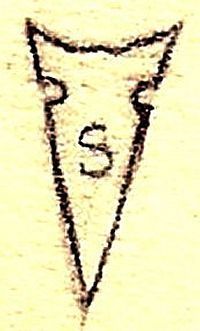
Close up of Studer’s logo, the traced
outline of an upside down Washita arrow point with a capital
“S” inside. Washita points are common at Antelope
Creek sites. PPHS archives. |
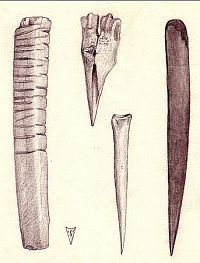
Drawing by Floyd Studer of Antelope Creek
bone tools. Studer was an artist as well as a photographer.
PPHS archives. |
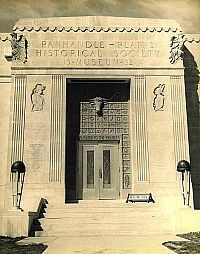
The Panhandle-Plains Historical Museum,
Texas’ first state historical museum, opened to the
public in 1933. It was created by the Panhandle-Plains Historical
Society in partnership with West Texas State Teachers College
(now West Texas A&M University). PPHS archives. |
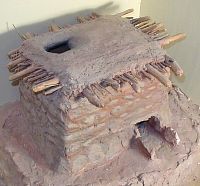
Scale model of an Antelope Creek house
as envisioned by Floyd Studer. The flat roof and roof entry
ideas are conjectural details that Studer borrowed from Southwestern
pueblos. This model was made during the WPA era and can still
be seen at the Panhandle-Plains Historical Museum. Photo by
Steve Black. |
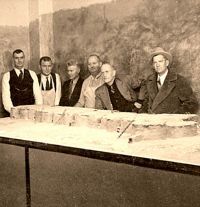
This photograph commemorates Warren King
Moorehead’s visit to the Panhandle-Plains Historical
Museum in 1938 or 1939. The men stand behind the detailed
interpretive model of Antelope Creek 22 built by WPA workers
under the direction of Floyd Studer. Studer is the man on
the far right and stands next to Moorehead. PPHS archives.
|
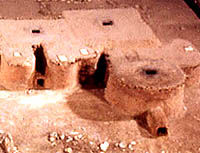
Detailed interpretive model of Antelope
Creek 22 built by WPA workers in the late 1930s under the
direction of Floyd Studer for permanent display at the Panhandle-Plains
Historical Museum. Studer based the model on the standing
pueblos of the nearby American Southwest; the flat roof, roof-top
ladder entries, and attached kiva (circular room at right)
were largely products of his imagination. PPHS archives. |
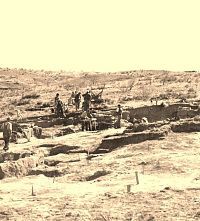
WPA excavations in progress at Alibates
Ruin 28, year unknown. PPHS archives. |
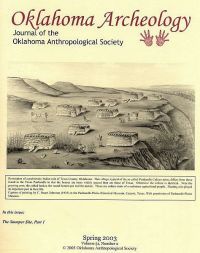
The first article in a fascinating four-part
series on the Stamper site appeared in the Spring 2003 edition
of Oklahoma Archeology. In this series, author Christopher
Lintz tells the intriguing story of the 1934-1935 excavations
at a large Plains village located near the North Canadian
River in Texas County, Oklahoma that is relevant to the ruins in Texas. |
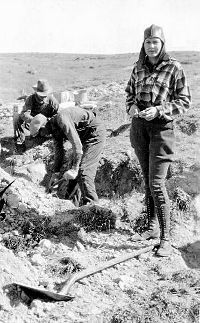
Margaret Johnston, stylishly attired in
a leather aviator’s hat and lace-up knee boots, visiting
Antelope Creek 22 during the WPA excavations in 1938 or 1939.
Courtesy Panhandle-Plains Historical Museum. |
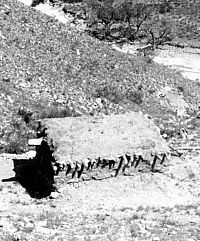
WPA field laboratory at Alibates 28. This
structure was built by the WPA crew to resemble the Antelope
Creek houses they were uncovering. The Southwestern-style
flat roof conformed to Studer’s ideas. PPHS archives. |
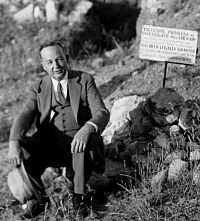
U.S. Congressman Marvin Jones during a
visit to Alibates Ruin 28, possibly in 1939. Studer brought
many influential citizens out to see the WPA work. Jones was
a powerful legislator and may have helped Studer and the WTSTC
gain continued WPA funding. PPHS archives. |
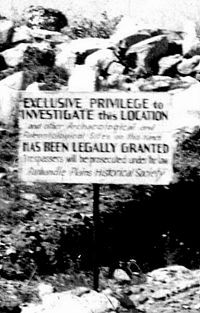
Printed sign Studer posted on the WPA
sites under investigation. “EXCLUSIVE PRIVILEGE to INVESTIGATE
this LOCATION and other Archaeological and Paleontological
Sites on this ranch HAS BEEN LEGALLY GRANTED. Trespassers
will be prosecuted under the law. Panhandle Plains Historical
Society.” PPHS archives. |
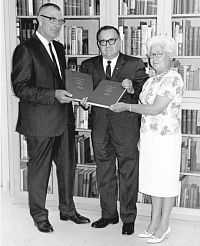
Ele and Jewel Baker present PPHM director
C. Boone McLure (on left) with bound copies of their WPA final
reports in special ceremony in 1968. The two volumes were
compiled and issued by the Alibates National Monument Committee
(Henry Hertner, chairman), but only four copies were printed.
Most would-be readers would have to wait until 2000, when
the Panhandle Archeological Society united the two volumes
under one cover and republished the Baker’s report.
PPHS archives. |
|
